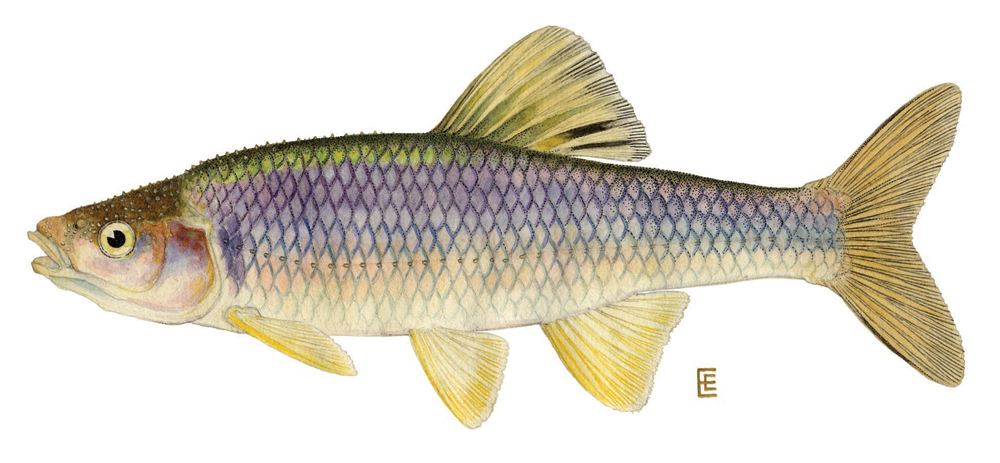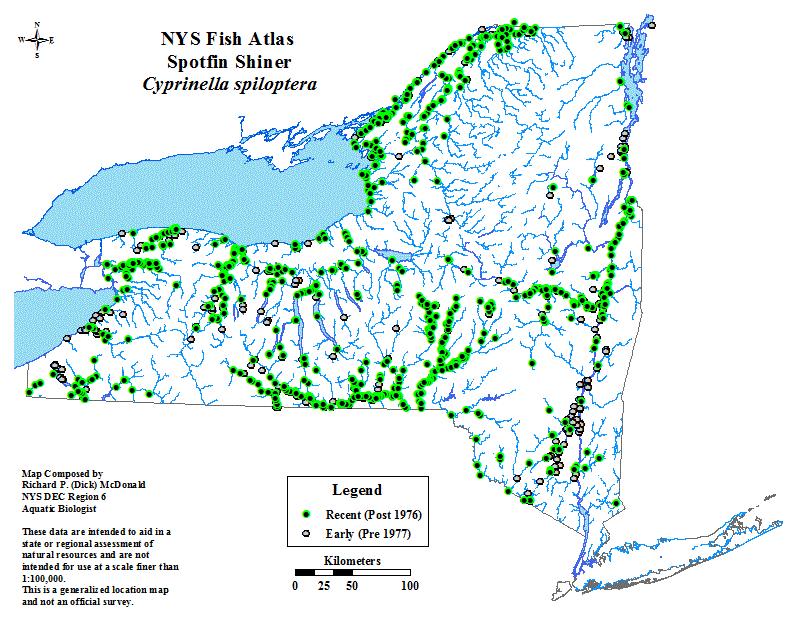
Spotfin Shiner (Notropis spilopterus)
The spotfin lives in lakes and in small to moderately large creeks. It appears to be quite tolerant of silty and turbid conditions. Breeding males have been collected in the abandoned Erie Canal near Vischer Ferry.
The eastern subspecies, N.s. spilopterus, ranges through the Ohio River and its tributaries from the Tennessee River in northern Alabama to the Wabash in Indiana and eastern Illinois, and east to Pennsylvania and western New York in the Allegheny system. In the Great Lakes, it occurs from eastern Michigan to the St. Lawrence near Montreal and south on the Atlantic coast to the Potomac River system. In western Michigan and Wisconsin, it intergrades with N. s. hypsisomatus, a deeper bodied form that ranges through the Upper Missis- sippi system from Minnesota to northeastern Oklahoma. In New York, it is widespread but absent from the Upper Genesee, the Adirondacks, and Tug Hill.
The spawning season in the Susquehanna River near Port Trevington, Pennsylvania, extended from mid-June to mid-August. The spotfin spawns in horizontal crevices in rocks and logs. Spawning groups of 10 to 30 fish, usually more females than males, gather at a suitable site. The males establish territories that include one or more crevices which can be as short as 2 cm but are usually longer. Defense of the territory includes fights where one male tries to grasp the pelvic or anal fin of the other and drag it away from the site. If each fish grabs the other, they swim in a circle with increasing speed until they can no longer hang on. The fins, especially the dorsal, are erected as a display before the attack begins.
After the territory is set up, the male makes one or more display passes along the crevice, vibrating his body and extending his pectoral fins and some- times the tail and caudal peduncle into the crevice. He then swims to a group of females and entices one female toward the crevice. Females ready to spawn make a prespawning pass along the crevice and then both partners swim along the crevice with the female slightly ahead and closer to the crevice. The fish turn on their sides if the crevice is horizontal. The presence of another male usually interrupts the spawning but occasionally a female or even another male is allowed to join the spawning pair. Males spawned in the same crevice several times with the same or with different females. Usually, the female stops spawning before the male ceases making display passes. The sight of a displaying female stimulates the male to spawn, thus the female selects the crevices in some cases.
Prespawning behavior may take an hour before spawning or only a few minutes. Spotfins are fractional spawners and spawn at intervals of 1 to 7 days, 5 days is the most common interval between spawnings. Up to three groups of eggs may be released during one spawning session. One female spawned 31 groups of eggs, each containing 10 to 97 eggs. Adults sometimes fed on eggs flushed from the crevices before they became attached to its walls.
It was observed that spotfins in the Huron River, Michigan, fed near the bottom during the day and nearer the surface at dawn and dusk when the feeding was most intense. During the daylight hours, trichopterans were the most important food but at night dipterans were the dominant food. Other insects, including coleopterans, lepidopterans, and terrestrial hymenopterans were a smaller part of the diet. The major peak in stomach fullness occurred around 9 pm.
Distribution of spotfin shiner in NY state.
A 403 KB image of the spotfin shiner is also available for download.
The above species description and all pictures of this fish were taken out of "The Inland Fishes of New York State" by C. Lavett Smith, published by the New York State Department of Environmental Conservation, 1985.
